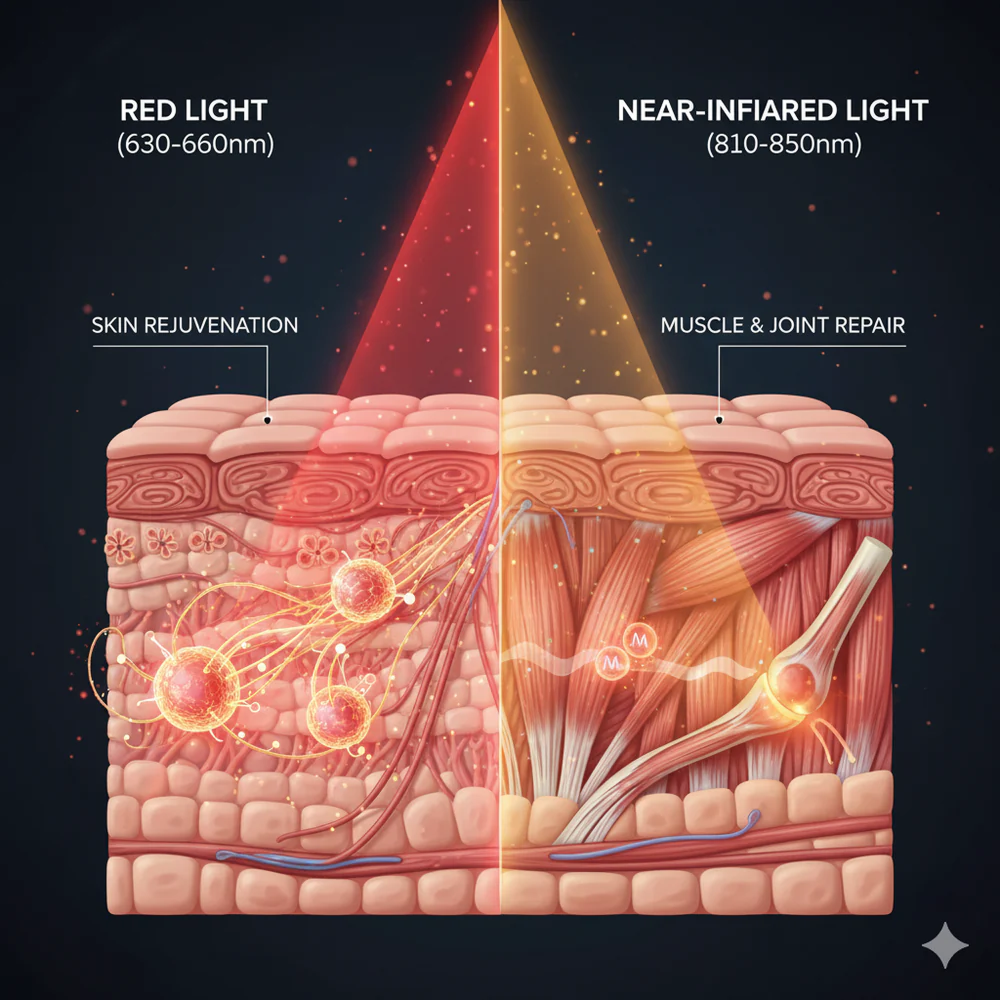How Deep Does Red Light Therapy Penetrate: The Science of Light Absorption

Red light therapy has emerged as a powerful, non-invasive modality for enhancing wellness, from skin rejuvenation to muscle recovery. But its effectiveness hinges on a fundamental question: how deeply does the light actually travel into the body? Understanding this penetration depth is key to unlocking its full potential. This article delves into the science behind light absorption, explaining why depth matters and how you can leverage this knowledge to achieve targeted, effective results for your specific health and wellness goals.
Why Penetration Depth is the Key to Efficacy
The therapeutic power of red light therapy isn't magic—it's a matter of physics and biology. For the light to have an effect, its photons must be absorbed by the target cells. If the light cannot reach the intended tissue layer, its benefits remain superficial.
-
For Skin Health: To stimulate fibroblasts in the dermis to produce more collagen and elastin, the light must penetrate past the outer layer (epidermis).
-
For Muscle Recovery: To reduce inflammation and aid repair within muscle tissue, the light needs to reach several centimeters deep.
-
For Joint Pain: To soothe an inflamed joint capsule, the light must penetrate through skin, fat, and connective tissue.
In short, the depth of penetration directly determines which conditions you can effectively target, making it the most critical factor in designing a successful treatment protocol.
The Primary Factors That Govern Light Penetration
Several key elements influence how far light can travel into your body:
-
Wavelength: This is the most important factor. Different wavelengths of light possess different energies and are absorbed by different components in the tissue. Shorter wavelengths are absorbed more readily, while longer wavelengths can travel deeper.
-
Output Power (Irradiance): Measured in milliwatts per square centimeter (mW/cm²), this is the power density of the light hitting your skin. A higher irradiance delivers more photons, which can enhance the therapeutic effect and support deeper penetration.
-
Skin and Tissue Composition: Factors like skin pigmentation, thickness, and the amount of subcutaneous fat can scatter or absorb light, slightly altering the effective depth for each individual.
-
Treatment Distance and Angle: Holding the device at the correct distance ensures optimal light delivery. Holding it too far away drastically reduces the energy reaching the skin.
A Breakdown of Penetration by Wavelength
The choice of wavelength is essentially your tool for targeting different areas of the body.
-
Red Light (630-670 nm): Penetrates superficially, reaching a depth of about 1 to 5 millimeters. This is ideal for targeting the epidermis and dermis, making it the go-to choice for:
-
Collagen production and anti-aging
-
Wound healing and scar reduction
-
Reducing inflammation in the skin (e.g., acne, rosacea)
-
Near-Infrared Light (NIR) (810-850 nm): Penetrates deeply, reaching depths of 2 to 5 centimeters or more. This allows it to bypass the skin and affect deeper structures, making it perfect for:
-
Muscle recovery and reducing soreness
-
Joint pain and arthritis
-
Bone healing and nerve regeneration
Does Red Light Therapy Reach the Dermis?
Yes, absolutely. This is one of its primary strengths. The dermis, located just beneath the epidermis, is where our vital collagen and elastin networks reside. Red light in the 630-670 nm range is specifically absorbed by the mitochondria within the fibroblasts in this layer. This energy boost supercharges these cells, leading to increased production of new collagen and elastin, which results in improved skin firmness, elasticity, and a reduction in fine lines.
Red vs. Near-Infrared: Choosing Your Tool
Think of red and near-infrared light as different tools for different jobs. The choice isn't about which is better, but about which is right for your goal.
-
Choose Red Light when your primary concern is skin health, anti-aging, and treating surface-level conditions. It's your tool for cosmetic and dermatological benefits.
-
Choose Near-Infrared Light when you need to address pain, inflammation, or recovery in muscles, joints, and deeper tissues. It's your tool for musculoskeletal and deep healing benefits.
Many advanced devices from The Thermo Lab offer both spectrums, allowing you to combine these effects for comprehensive treatment.
A Practical Guide for Optimal Penetration and Results
-
Match the Wavelength to Your Goal: Be intentional. Use red light for skin on your face and NIR for a sore knee or shoulder.
-
Ensure Proper Device Power: For effective deep-tissue treatment, a device needs sufficient irradiance. Look for devices that provide clinical-grade power levels for home use.
-
Maintain Consistent Distance: Follow the manufacturer's guidelines, typically 6-12 inches from the skin, to ensure the light beam covers the area effectively and delivers the promised energy density.
-
Be Consistent with Timing: Sessions of 10-20 minutes per area are standard. Consistency (e.g., 3-5 times per week) is far more important than occasional long sessions, as the effects are cumulative.
-
Prepare the Treatment Area: Apply the light to clean, bare skin. Avoid barriers like thick clothing or lotions that could reflect or block the light.
Conclusion
The "depth" of red light therapy is not a mystery, but a well-understood scientific principle. By recognizing that red light targets skin-deep rejuvenation and near-infrared light reaches deep into muscles and joints, you can move beyond generic use and into targeted, strategic applications. This knowledge empowers you to select the right tools and protocols, transforming red light therapy from a general wellness practice into a precise and powerful modality for achieving your specific health and aesthetic objectives.
Final Thoughts
At The Thermo Lab, we believe in empowering your wellness journey with clarity and scientific understanding. Knowing how light interacts with your body is the first step toward achieving meaningful results. Explore our curated selection of advanced light therapy devices, engineered to deliver specific wavelengths at optimal power for targeted penetration. Discover the difference that precision makes.



